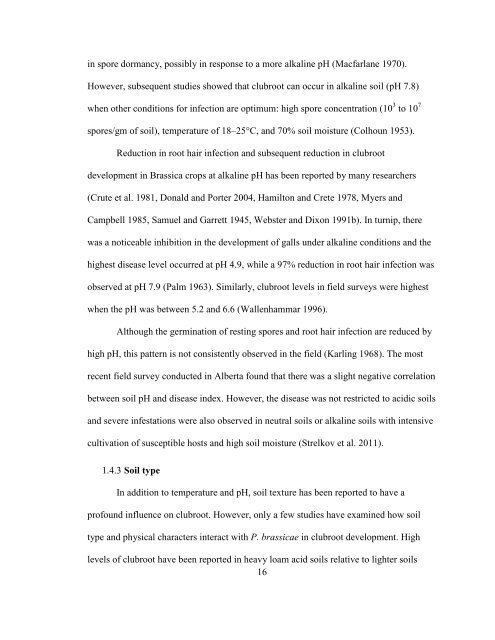Hema Kasinathan Thesis May 1 2012.pdf - Atrium - University of ...
Hema Kasinathan Thesis May 1 2012.pdf - Atrium - University of ...
Hema Kasinathan Thesis May 1 2012.pdf - Atrium - University of ...
You also want an ePaper? Increase the reach of your titles
YUMPU automatically turns print PDFs into web optimized ePapers that Google loves.
in spore dormancy, possibly in response to a more alkaline pH (Macfarlane 1970).However, subsequent studies showed that clubroot can occur in alkaline soil (pH 7.8)when other conditions for infection are optimum: high spore concentration (10 3 to 10 7spores/gm <strong>of</strong> soil), temperature <strong>of</strong> 18–25°C, and 70% soil moisture (Colhoun 1953).Reduction in root hair infection and subsequent reduction in clubrootdevelopment in Brassica crops at alkaline pH has been reported by many researchers(Crute et al. 1981, Donald and Porter 2004, Hamilton and Crete 1978, Myers andCampbell 1985, Samuel and Garrett 1945, Webster and Dixon 1991b). In turnip, therewas a noticeable inhibition in the development <strong>of</strong> galls under alkaline conditions and thehighest disease level occurred at pH 4.9, while a 97% reduction in root hair infection wasobserved at pH 7.9 (Palm 1963). Similarly, clubroot levels in field surveys were highestwhen the pH was between 5.2 and 6.6 (Wallenhammar 1996).Although the germination <strong>of</strong> resting spores and root hair infection are reduced byhigh pH, this pattern is not consistently observed in the field (Karling 1968). The mostrecent field survey conducted in Alberta found that there was a slight negative correlationbetween soil pH and disease index. However, the disease was not restricted to acidic soilsand severe infestations were also observed in neutral soils or alkaline soils with intensivecultivation <strong>of</strong> susceptible hosts and high soil moisture (Strelkov et al. 2011).1.4.3 Soil typeIn addition to temperature and pH, soil texture has been reported to have apr<strong>of</strong>ound influence on clubroot. However, only a few studies have examined how soiltype and physical characters interact with P. brassicae in clubroot development. Highlevels <strong>of</strong> clubroot have been reported in heavy loam acid soils relative to lighter soils16
















